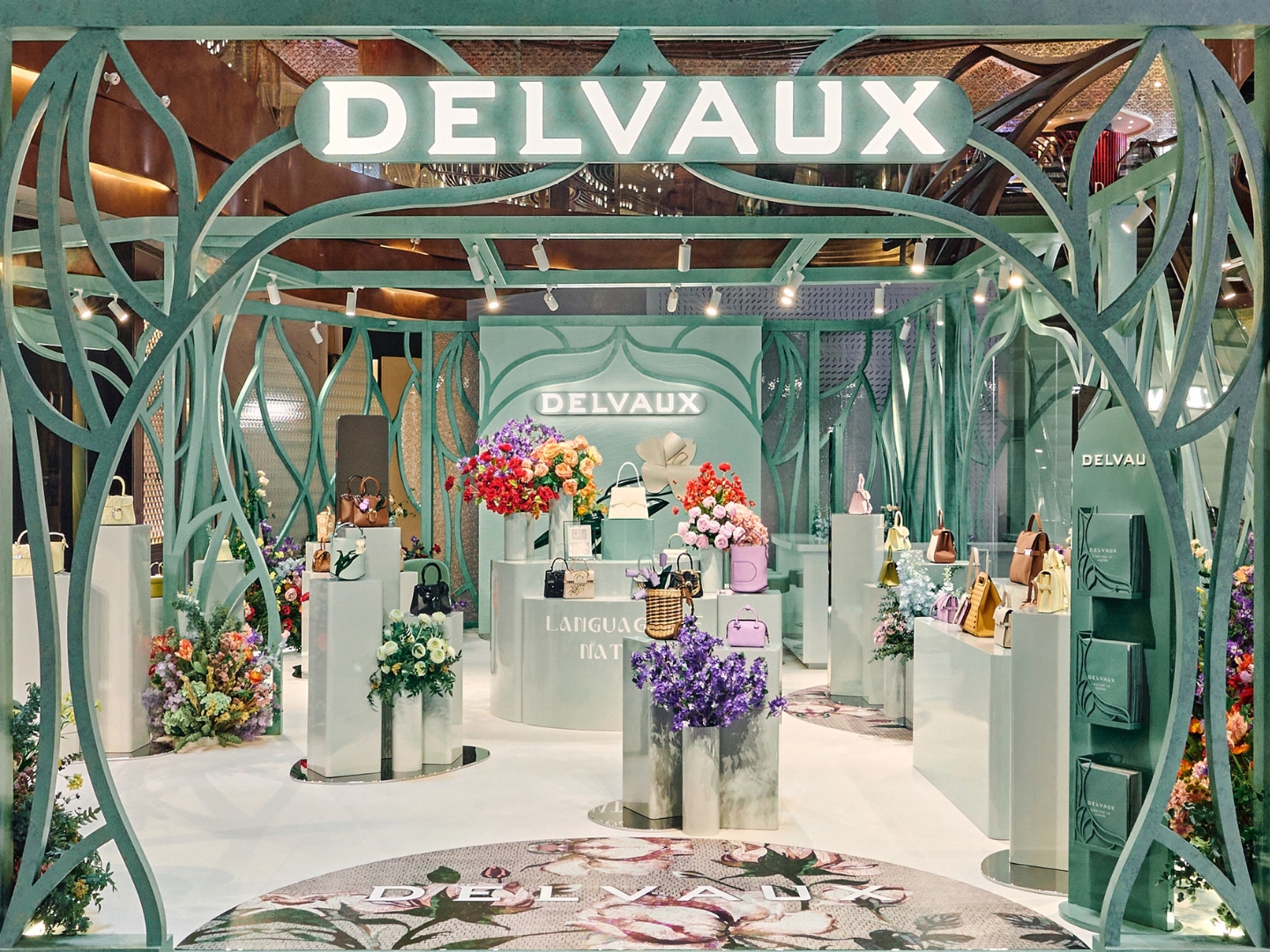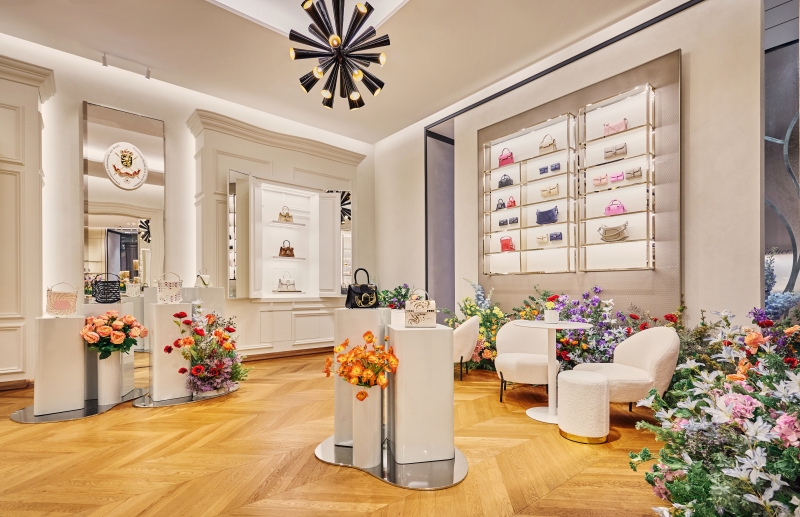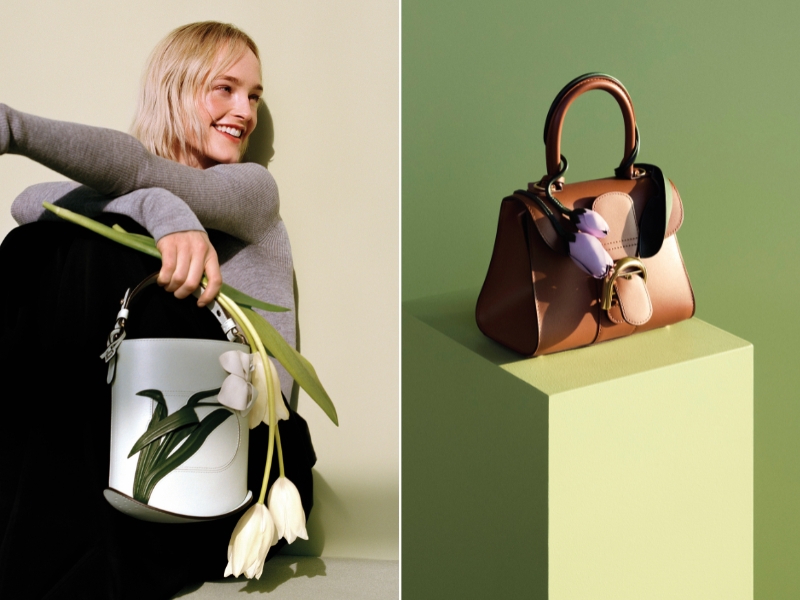
The K11 Musea pop-up is a flury of feminine colours and historic art references (All photos: Delvaux)
Those passionate about Greek mythology will probably be familiar with the Ouroboros — a circular motif depicting a serpent, or less commonly a dragon, swallowing its own tail. This curious symbol dating back to 5000 BC (the oldest known example is engraved on a 7,000-year-old jar that once belonged to the neolithic Yangshao People of eastern China, who made homes along the bank of the Yellow River) has embellished the tomes and artefacts of several cultures and kingdoms throughout history. It symbolises eternity and even immortality, referencing nature’s ruthless pattern of self-destruction followed by rebirth, as well as the strict equilibrium of life and death.
The reptile’s concepts are perhaps best observed in the natural world — it was supposedly inspired by real snakes, lizards and other creatures like pangolins that curl up to protect themselves from predators and the elements — specifically the cycle of the seasons. The promise of warmer spring days after a freezing winter is what moves millions to brave the bitter cold each year. The sight of tiny unassuming blossoms peeking through defrosting branches is an indication that the wait will soon be over and, better yet, worthwhile. Thus, budding blooms, a lot less menacing looking than the
self-devouring ophidian, have become a modern icon of hope and rejuvenation.
Despite all this, the 21st century style buff’s favourite, and admittedly overused, tenet — “Florals for spring? Groundbreaking.”, as icily delivered by intimidating editor Miranda Priestly in The Devil Wears Prada — is perhaps the most commonly recited response to a fashion house launching floral motifs for the Spring/Summer season. Still, vernal foliage is the simplest, most palpable sign of better times to come, a memo that the sun shines again even after the most sombre of rainstorms. The clothes and accessories we put on each morning should, after all, make us feel optimistic about the day ahead. So, florals continue to be hot from haute couture to the high street, despite the humdrum reputation some people thrust upon them.
Additionally, the ongoing revival of the flower child aesthetic of the late 1960s and 1970s, wherein psychedelic patterns and loud bucolic prints were “it”, points not only to fashion’s cyclical setup cloning that of Mother Nature’s, but a heightened craving for colour, romanticism and a return to simple, reliable joys (the “good old times”, if you will) amid turbulent reality. The small slices of beauty around us are a reminder of the planet’s resilience — to be inspired by it so we might put out splendour into the world, time and again. Delvaux, the oldest luxury leather goods maison, certainly knows a thing or two about that.
pop_up_close_up.jpg

As the final remnants of snow melted away, the Belgian brand launched its Language of Nature collection, demonstrating how fine craftsmanship, paired with a desire to see the whimsical and beautiful in the ordinary, breathes new life into the “démodé”. The latest opus of bags and small leather goods celebrates a femininity that is simultaneously confident and romantic, becoming an ode to the undying romance between design and nature.
The line is also a testament to the label’s dedication to art or, at least, the most recent following its smashing 125th anniversary capsule in 2023 dedicated to the mystifying works of surrealist painter René Magritte. In this Spring/Summer release, the brand reformulates the essence of Art Nouveau, an ornamental style most popularly featured in American and European illustrations, jewellery and interior design produced between 1890 and 1910.
Art Nouveau began in protest against the societal impacts of industrialism. Characterised by sinuous, organic lines often taking the form of flower stalks, vines, insect wings and other delicate natural objects, the movement gave rise to several doyens of the arts, including Scottish designer and spearhead of the Vienna Secession (the unionisation of Austrian artists which began in 1897) Charles Rennie Mackintosh, American glassworker Louis Comfort Tiffany (son of Charles Lewis Tiffany, founder of the stationery producer that eventually became luxury jeweller Tiffany & Co), as well as English poet and textile designer William Morris.
Having said that, no master is as well suited to be the primary inspiration for the proudly Belgian maison than Victor Horta. The Ghent-born architect and professor at the Université Libre de Bruxelles is largely credited with shaping the city of Brussels, into a key Art Nouveau destination, thanks to his work on landmarks like the Maison du Peuple, Brussels-Central Railway Station and Brussels Centre for Fine Arts. Exposed iron accents, organic shapes and whiplash curves are just some of his signature elements that can still be observed all around the Belgian capital today.
hk_k11_musea_boutique_121.jpg

Now, Horta’s fascination with winding forms and botanical imagery finds a new home at Delvaux’s Language of Nature pop-up at K11 Musea mall in Hong Kong. A hop, skip and jump away from the label’s flagship boutique, which has also been festooned with lavish bouquets and an adorable flower cart at the entrance, the turquoise gazebo is right on theme with the era of focus. Pillars branch out to form undulating, asymmetrical lines, evoking the look of overlapping leaves on a lush thicket. Panes of frosted glass fit some of the apertures, emulating the mosaic glasswork popular during the Art Nouveau period.
Past the entry archway, guests step into a flourishing Eden, greeted first by a Cool Box bag. Crafted from Taurillon Soft leather, this lilac (officially named Guimauve) rendition of Delvaux’s arguably most carefree and youthful silhouette comes with white hand-embroidered flowers and is complete with a signature silver D buckle and matching hardware. Next to this darling number sit two Pin Minis. One dons the same purple hue and ingénue floral-shaped stitching, while the Osier version beside it boasts a stunning French wicker body. Styled with a bouquet of leather tulips spilling out of the top and draped around the lip, this handwoven unit is reminiscent of picnic baskets. Its more structured primary material is complemented by sumptuous Dream Calf details and a removable interior canvas pouch with drawstring closure.
At the next display island, visitors encounter a trio of purses adorned with 3D sculpted blooms. An embossed tulip, plush to the touch, with a deep emerald stem wraps around the top handle of a Brillant Mini in tan calfskin. Of course, balance is what keeps nature running, and so a tone-on-tone black double perches nearby, the inky yin to its sibling’s sunnier yang. Another Pin accompanies the twins, this time taking on a powdery mint tone. A single iris stalk lolls across the front, an example of the house’s deft leather marquetry technique. (Tip: For the perfect Instagram post, look for the photo wall adorned with a larger-than-life version of this flower.)
To the left sits another trinity of bags in the collection’s winning Vanilla shade, a buttery pastel yellow that conjures up nostalgic flashbacks of the namesake ice cream flavour savoured on a hot day. The Brillant, Pin and Tempête here all sport the Sweet Daisy motif — an iridescent ensemble of flaxen glass beads and flower-shaped sequins, sewn together to create sparkling bunches across the leather surfaces. Take a peep at the kiosk behind this one, and you will be rewarded with a more vogue edition: a Caprice Toy finished with a tall, sculptural metallic handle that offers contemporary zhuzh to the feminine, cheery colourway.
bag_collage.jpg

Another standout style arrives in the form of the Arsenal Flora design, which reimagines the laidback form of the Pin bag with an all-over embellishment made from small leather D’s, embossed and arranged in fish scale-like manner. Alternating colours come together like a jigsaw puzzle to depict a pattern of six-petaled flowers with centre discs in egg-yolk yellow.
Beyond botanic themes, the Art Nouveau period is also known for its tilework, said to be among the most awe-inspiring in history for its intricate designs and richly hued glazes. These ceramic creations were the finishing touch for buildings interiors and façades, and are among the epoch’s most easily recognisable elements. During this time, it was also common to find decorative inlays in many Belgian townhouse floors, crafted by cutting recessions into a base material (typically wood) and filling it with a contrasting medium to make a pattern.
These luminous floor finishings get their moment in the sun at the heart of Delvaux’s pavilion, where a Brillant Mini and Tempête Small take on Mosaïques embroideries. Painstakingly handsewn glass beads, tinier than common black garden ants, glimmer under light and demand closer inspection, turning these bags into true objets d’art perfect for the most zealous of Delvaux collectors who will not only wear them proudly, but view them as fashionable studies in light and material.
Additionally, a black Toy Caprice and Brillant Mini with gold hardware use delicate pearls and metallic thread to emulate the look of gilded ironwork (called ferronnerie), curled and manipulated to mimic creepers. These wrought iron details were standard across Horta’s architectural portfolio. The best example is perhaps Tassel House, a residence commissioned by his fellow maison and university colleague Emile Tassel. Known for its dreamy central stairwell where slender iron columns burst into a tangle of vines at their crowns, mirrored in the whiplash curls of plant tendrils in the floor mosaic and wall murals, the dwelling is often cited as the first-ever Art Nouveau building.
brilliant_mini.jpg

As if these haute couture carriers did not already echo history enough, a model of Delvaux’s le Princesse, the world’s first-ever patented handbag, sits like an archival crown jewel amidst the maison’s latest offerings, a true blast from the past. Guests who swing by will probably spot several bags and pouches from the previous Margritte collection dotted around the space, like the Brillant Mini Wavy in Bonbon pink and fruit-shaped La Pomme crossbodies. These glimpses into recent and long-gone years urge one to reflect on seasons past and be thankful for them, no matter how joyous or arduous, as they paved the way for us to relish the present.
The label’s iconic bags, including the L’Airess tote, as well as its Pin D and Vagabond wallets, may also be found in the refreshing hues of Kiwi, Pool, Sesame and Honey. Much like the season it honours, the ongoing Hong Kong pop-up is fleeting, running only until June 2 before it returns to its roots in Belgium (should you find yourself there soon, drop by The Botanic Hotel/Botanic Sanctuary in Antwerp to see the pieces). The brand’s Spring/Summer oeuvre, possibly its most expressive to date for this time of year, is a prompt to have faith in life’s continuity, to know without a doubt that April showers bring May flowers.
This article first appeared on May 26, 2025 in The Edge Malaysia.


